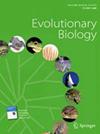上位论与进化论
IF 1.7
2区 生物学
Q3 EVOLUTIONARY BIOLOGY
引用次数: 3
摘要
上位论的概念在一百多年前被引入进化论。关于其在进化过程中的重要性,其历史充满了争议,罗纳德·费舍尔和塞沃尔·赖特在现代综合之后的辩论就是例证。在这种情况下,分歧在于适应性景观的形状,这是由上位性决定的。Wright认为上位性导致适应性景观崎岖不平,有许多局部山峰,而Fisher则认为进化是一个平稳、稳定的过程,朝着一个独特的最佳状态发展。即使在今天,上位论的不同含义仍在继续引发混乱。然而,一种共识正在形成,根据这种共识,该术语应用于最广泛意义上指定表型的遗传效应之间的相互作用。换句话说,在上位性的情况下,基因的表型效应取决于其遗传背景。在进化论中,主要关注的表型是生物体适应度,但这一概念主要适用于任何基因型-表型图谱。在整个20世纪,上位性通常被认为是对单个基因主要影响的残余扰动,这反映了菲舍尔的观点。然而,随着测序技术的出现,深入了解基因型-表型图谱的分子基础,在过去的二十年里,上位性是一种规律,而不是例外。这促使大量实证研究在生物体和基因组复杂性的大范围内探索上位性的模式和进化后果。相应地,已经开发了用于分析实验数据的数学和计算工具,并构建了模型来阐明遗传相互作用的机制和统计起源。尽管存在一定的内在模糊性,但这一概念在现代进化思想中占据了中心地位,成为组织对基因型、表型和生物体之间关系不断积累的理解的框架。本文章由计算机程序翻译,如有差异,请以英文原文为准。
Epistasis and Evolution
The concept of epistasis was introduced into evolutionary theory more than a hundred years ago. Its history is marked by controversies regarding its importance for the evolutionary process, as exemplified by the debate between Ronald Fisher and Sewall Wright in the wake of the modern synthesis. In this case the disagreement was about the shape of the adaptive landscape, which is determined by epistasis. Wright believed that epistasis causes the adaptive landscape to be rugged with many local peaks, whereas Fisher viewed evolution as a smooth, steady progression toward a unique optimum. Even today, the different meanings attributed to epistasis continue to spawn confusion. Nevertheless, a consensus is emerging, according to which the term should be used to designate interactions between genetic effects on phenotypes in the broadest sense. Stated differently, in the presence of epistasis the phenotypic effects of a gene depend on its genetic context. In evolutionary theory the phenotype of primary interest is organismal fitness, but principally the concept applies to any genotype-phenotype map. Reflecting the Fisherian view, throughout the 20th century epistasis was often considered to be a residual perturbation on the main effects of individual genes. Following the advent of sequencing techniques providing insights into the molecular basis of genotype-phenotype maps, over the past two decades it has become clear, however, that epistasis is the rule rather than an exception. This has motivated a large number of empirical studies exploring the patterns and evolutionary consequences of epistasis across a wide range of scales of organismal and genomic complexity. Correspondingly, mathematical and computational tools have been developed for the analysis of experimental data, and models have been constructed to elucidate the mechanistic and statistical origins of genetic interactions. Despite a certain inherent vagueness, the concept takes center stage in modern evolutionary thought as a framework for organizing the accumulating understanding of the relationship among genotype, phenotype, and organism.
求助全文
通过发布文献求助,成功后即可免费获取论文全文。
去求助
来源期刊

Evolutionary Biology
生物-进化生物学
CiteScore
3.80
自引率
4.00%
发文量
25
审稿时长
>12 weeks
期刊介绍:
The aim, scope, and format of Evolutionary Biology will be based on the following principles:
Evolutionary Biology will publish original articles and reviews that address issues and subjects of core concern in evolutionary biology. All papers must make original contributions to our understanding of the evolutionary process.
The journal will remain true to the original intent of the original series to provide a place for broad syntheses in evolutionary biology. Articles will contribute to this goal by defining the direction of current and future research and by building conceptual links between disciplines. In articles presenting an empirical analysis, the results of these analyses must be integrated within a broader evolutionary framework.
Authors are encouraged to submit papers presenting novel conceptual frameworks or major challenges to accepted ideas.
While brevity is encouraged, there is no formal restriction on length for major articles.
The journal aims to keep the time between original submission and appearance online to within four months and will encourage authors to revise rapidly once a paper has been submitted and deemed acceptable.
 求助内容:
求助内容: 应助结果提醒方式:
应助结果提醒方式:


